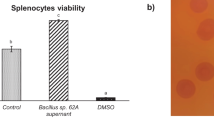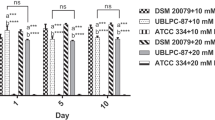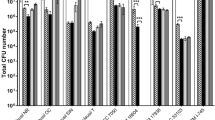Abstract
To screen Bacillus clausii UBBC07 as a putative probiotic strain and to examine the protective effect of probiotic—B. clausii UBBC07 spore on uremia on rats induced by acetaminophen. In vitro tests performed to screen potential probiotic strains were gastric and bile acid resistance and ability to reduce pathogen adhesion to surfaces. An in vivo study was performed on rats (n = 18) which were randomly divided into three groups: group I, control—receives normal food and water, groups II and III receive acetaminophen i.p. at the dose of 550 mg/kg/day for 10 days, groups III was treated with B. clausii UBBC07 at a dose of 1 × 109 CFU/day for 15 days. Urea, creatinine, malondialdehyde (MDA), and GSH levels and antioxidant enzymes like super oxide dismutase (SOD) and catalase activity were considered to analyze renal failure. Plasma urea and creatinine levels (p < 0.05) significantly increase and SOD, catalase, and GSH activity level significantly decrease in group II as compared with the control group. After treatment with probiotic, there was a significant increase in SOD and catalase (p < 0.05) and a significant decrease in serum urea, creatinine, and MDA (p < 0.05) in group III in response to group II. The results also revealed that probiotic was able to tolerate pH 3.0–9.0 and 0.3% bile salt. The present study suggests that B. clausii UBBC07 could be used as a novel alternative natural therapy for uremia, a major syndrome of CKD.
Similar content being viewed by others
References
Pradhan S, Mandal S, Roy S, Mandal A, Das K, Nandi DK (2013) Attenuation of uremia by orally feeding alpha-lipoic acid on acetaminophen induced uremic rats. Saudi Pharm J 21:187–192. https://doi.org/10.1016/j.jsps.2012.03.003
James LP, Mayeux PR, Hinson JA (2003) Acetaminophen-induced hepatotoxicity. Drug Metab Dispos 31:1499–1506. https://doi.org/10.14218/JCTH.2015.00052
Moore M, Thor H, Moore G, Nelson S, Moldéus P, Orrenius S (1985) The toxicity of acetaminophen and N-acetyl-p-benzoquinone imine in isolated hepatocytes is associated with thiol depletion and increased cytosolic Ca2+. J Biol Chem 260:13035–13040. http://www.jbc.org/content/260/24/13035.long
Patra A, Mandal S, Samanta A, Chandra MK, Nandi DK (2018) Therapeutic potential of probiotic Lactobacillus plantarum AD3 on acetaminophen induced uremia in experimental rats. Clin Nutr Exp 19:12–22. https://doi.org/10.1016/j.yclnex.2018.02.002
Patra A, Mandal A, Roy S, Mandal S, Mondal KC, Nandi DK (2014) Protective effect of selected urease positive Lactobacillus strains on acetaminophen induced uremia in rats. Biomed Prev Nutr 4:271–276. https://doi.org/10.1016/j.bionut.2014.02.001
Koppe L, Fouque D, Soulage CO (2018) The role of gut microbiota and diet on uremic retention solutes production in the context of chronic kidney disease. Toxins 10:E55. https://doi.org/10.3390/toxins10040155
Glorieux G, Tattersall J (2015) Uraemic toxins and new methods to control their accumulation: game changers for the concept of dialysis adequacy. Clin Kidney J 8:353–362. https://doi.org/10.1093/ckj/sfv034
Ramezani A, Massy ZA, Meijers B, Evenepoel P, Vanholder R, Raj DS (2016) Role of the gut microbiome in uremia: a potential therapeutic target. Am J Kidney Dis 67:483–498. https://doi.org/10.1053/j.ajkd.2015.09.027
O’Bryan CA, Pak D, Crandall PG, Lee SO, Ricke SC (2013) The role of prebiotics and probiotics in human health. J Prob Health 1:2. https://doi.org/10.4172/2329-8901.1000108
Pandey KR, Naik SR, Vakil BV (2015) Probiotics, prebiotics and synbiotics- a review. J Food Sci Technol 52:7577–7587. https://doi.org/10.1007/s13197-015-1921-1
Vanholder R, Glorieux G (2015) The intestine and the kidneys: a bad marriage can be hazardous. Clin Kidney J 8:168–179. https://doi.org/10.1093/ckj/sfv004
Cutting SM (2011) Bacillus probiotics. Food Microbiol 28:214–220
Lakshmi SG, Jayanthi N, Saravanan M, Ratna MS (2017) Safety assessment of Bacillus clausii UBBC07, a spore forming probiotic. Toxicol Rep 4:62–71. https://doi.org/10.1016/j.toxrep.2016.12.004
Urdaci MC, Bressollier P, Pinchuk I (2004) Bacillus clausii probiotic strains antimicrobial and immunomodulatory activities. J Clin Gastroenterol 38:S86–S90. https://doi.org/10.1097/01.mcg.0000128925.06662.69
Jayanthi N, Sudha RM (2015) Bacillus clausii-the probiotic of choice in the treatment of diarrhoea. J Yoga Phys Ther 5:1. https://doi.org/10.4172/2157-7595.1000211
Hyronimus B, Le Marrec C, Hadj Sassi A, Deschamps A (2000) Acid and bile tolerance of spore-forming lactic acid bacteria. Int J Food Microbiol 61:193–197. https://doi.org/10.1016/S0168-1605(00)00366-4
Marklund S, Marklund G (1974) Involvement of the superoxide anion radical in the autoxidation of pyrogallol and a convenient assay for superoxide dismutase. Eur J Biochem 47:469–474. https://doi.org/10.1111/j.1432-1033.1974.tb03714.x
Beers RF, Sizer IW (1952) A spectrophotometric method for measuring the breakdown of hydrogen peroxide by catalase. J Biol Chem 195:133–140. http://www.jbc.org/content/195/1/133.full.pdf
Ellman GL (1959) Tissue sulfhydryl groups. Arch Biochem Biophys 82:70–77. https://doi.org/10.1016/0003-9861(59)90090-6
Ohkawa H, Ohishi N, Yagi K (1979) Assay for lipid peroxides in animal tissues by thiobarbituric acid reaction. Anal Biochem 95:351–358. https://doi.org/10.1016/0003-2697(79)90738-3
Fijan S (2014) Microorganisms with claimed probiotic properties: an overview of recent literature. Int J Environ Res Public Health 11:4745–4767. https://doi.org/10.3390/ijerph110504745
Kim SY, Moon A (2012) Drug-induced nephrotoxicity and its biomarkers. Biomol Ther 20:268–272. https://doi.org/10.4062/biomolther.2012.20.3.268
Bouhafs L, Moudilou EN, Exbrayat JM, Lahouel M, Idoui T (2015) Protective effects of probiotic Lactobacillus plantarum BJ0021 on liver and kidney oxidative stress and apoptosis induced by endosulfan in pregnant rats. Ren Fail 37:1370–1378. https://doi.org/10.3109/0886022X.2015.1073543
Sall M, Dou L, Cerini C, Poitevin S, Brunet P, Burtey S (2014) The aryl hydrocarbon receptor-activating effect of uremic toxins from tryptophan metabolism: a new concept to understand cardiovascular complications of chronic kidney disease. Toxins 6:934–949. https://doi.org/10.3390/toxins6030934
Poesen R, Windey K, Neven E, Kuypers D, De Preter V, Augustijns P, D’Haese P, Evenepoel P, Verbeke K, Meijers B (2015) The influence of CKD on colonic microbial metabolism. J Am Soc Nephrol 27:1389–1399. https://doi.org/10.1681/ASN.2015030279
Vaziri ND, Wong J, Pahl M, Piceno YM, Yuan J, DeSantis TZ, Ni Z, Nguyen TH, Andersen GL (2013) Chronic kidney disease alters intestinal microbial flora. Kidney Int 83:308–315. https://doi.org/10.1038/ki.2012.345
Wong J, Piceno YM, DeSantis TZ, Pahl M, Andersen GL, Vaziri ND (2014) Expansion of urease and uricase-containing, indole- and p-cresol-forming and contraction of short chain fatty acid-producing intestinal bacteria in ESRD. Am J Nephrol 39:230–237. https://doi.org/10.1159/000360010
Hida M, Aiba Y, Sawamura S, Satoh T, Koga Y (1996) Inhibition of the accumulation of uremic toxins in the blood and their precursors in the feces after oral administration of Lebenin, a lactic acid bacteria preparation, to uremic patients undergoing hemodialysis. Nephron 74:349–355. https://doi.org/10.1159/000189334
Takayama F, Taki K, Niwa T (2003) Bifidobacterium in gastro-resistant seamless capsule reduces serum levels of indoxyl sulfate in patients on hemodialysis. Am J Kidney Dis 41:S142–S145. https://doi.org/10.1053/ajkd.2003.50104
Ranganathan N, Patel BG, Ranganathan P, Marczely J, Dheer R, Pechenyak B, Dunn SR, Verstraete W, Decroos K, Mehta R, Friedman EA (2006) In vitro and in vivo assessment of intraintestinal bacteriotherapy in chronic kidney disease. ASAIO J 52:70–79. https://doi.org/10.1097/01.mat.0000191345.45735.00
Ranganathan N, Ranganathan P, Friedman EA, Joseph A, Delano B, Goldfarb DS, Tam P, Rao AV, Anteyi E, Musso CG (2010) Pilot study of probiotic dietary supplementation for promoting healthy kidney function in patients with chronic kidney disease. Adv Ther 27:634–647. https://doi.org/10.1007/s12325-010-0059-9
Miranda Alatriste PV, Urbina Arronte R, Gomez Espinosa CO, Espinosa Cuevas MD (2014) Effect of probiotics on human blood urea levels in patients with chronic renal failure. Nutr Hosp 29:582–590. https://doi.org/10.3305/nh.2014.29.3.7179
Natarajan R, Pechenyak B, Vyas U, Ranganathan P, Weinberg A, Liang P, Mallappallil MC, Norin AJ, Friedman EA, Saggi SJ (2014) Randomized controlled trial of strain-specific probiotic formulation (Renadyl) in dialysis patients. Biomed Res Int 2014:568–571. https://doi.org/10.1155/2014/568571
Ramezani A, Raj DS (2014) The gut microbiome, kidney disease, and targeted interventions. J Am Soc Nephrol 25:657–670. https://doi.org/10.1681/ASN.2013080905
Simenhoff ML, Dunn SR, Zollner GP, Fitzpatrick ME, Emery SM, Sandine WE, Ayres JW (1996) Biomodulation of the toxic and nutritional effects of small bowel bacterial overgrowth in end-stage kidney disease using freeze-dried Lactobacillus acidophilus. Miner Electrolyte Metab 22:92–96
Dunn SR, Simenhoff ML, Ahmed KE, Gaughan WJ, Eltayeb BO, Fitzpatrick ME, Emery SM, Ayres JW, Holt KE (1998) Effect of oral administration of freeze-dried Lactobacillus acidophilus on small bowel bacterial overgrowth in patients with end stage kidney disease: reducing uremic toxins and improving nutrition. Int Dairy J 8:545–553. https://doi.org/10.1016/S0958-6946(98)00081-8
Prakash S, Chang TM (1996) Microencapsulated genetically engineered live E. coli DH5 cells administered orally to maintain normal plasma urea level in uremic rats. Nat Med 2:883–887. https://doi.org/10.1038/nm0896-883
Acknowledgments
The authors gratefully acknowledge Unique Biotech Limited, Unit-II, Hyderabad, India for supplying probiotic strains of Bacillus clausii.
Author information
Authors and Affiliations
Corresponding author
Ethics declarations
Institutional Animal Ethics Committee approved the experimental protocol SSR/IAEC/2018/08.The handling of the laboratory animals was performed according to CPCSEA guideline, India.
Conflict of Interest
The authors declare that they have no conflict of interest.
Additional information
Publisher’s Note
Springer Nature remains neutral with regard to jurisdictional claims in published maps and institutional affiliations.
Rights and permissions
About this article
Cite this article
Patel, C., Patel, P. & Acharya, S. Therapeutic Prospective of a Spore-Forming Probiotic—Bacillus clausii UBBC07 Against Acetaminophen-Induced Uremia in Rats. Probiotics & Antimicro. Prot. 12, 253–258 (2020). https://doi.org/10.1007/s12602-019-09540-x
Published:
Issue Date:
DOI: https://doi.org/10.1007/s12602-019-09540-x




